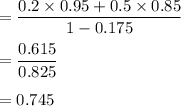
Mathematics, 19.09.2019 20:00 nicolehathaway1012
Suppose that an insurance company classifies people into one of three classes — good risks, average risks, and bad risks. their records indicate that the probabilities that good, average, and bad risk persons will be involved in an accident over a 1-year span are, respectively, .05, .15, and .30. if 20 percent of the population are "good risks," 50 percent are "average risks," and 30 percent are "bad risks," what proportion of people have accidents in a fixed year? if policy holder a had no accidents in 1987, what is the probability that he or she is a good (average) risk?

Answers: 3


Another question on Mathematics

Mathematics, 21.06.2019 15:00
Abcd is a parallelogram. the diagram is not drawn to scale. if m
Answers: 2

Mathematics, 22.06.2019 00:00
What is the effect on the graph of the function f(x) = x2 when f(x) is changed to f(x) − 4?
Answers: 1

Mathematics, 22.06.2019 01:10
To find the inverse of a number a, one can use the equation f(c) = a-1/c=0 where c is the inverse of a use the secant method of finding roots of equations to find the inverse of a = 2.5 ,er = 0.001%
Answers: 3

Mathematics, 22.06.2019 02:50
04.05 graphing exponential functions write an exponential function to represent the spread of bens social media post
Answers: 1
You know the right answer?
Suppose that an insurance company classifies people into one of three classes — good risks, average...
Questions

Social Studies, 24.11.2020 07:40


Mathematics, 24.11.2020 07:40

Mathematics, 24.11.2020 07:40

History, 24.11.2020 07:40

Physics, 24.11.2020 07:40

Mathematics, 24.11.2020 07:40

Mathematics, 24.11.2020 07:40

Mathematics, 24.11.2020 07:40

Social Studies, 24.11.2020 07:40


Mathematics, 24.11.2020 07:40






Computers and Technology, 24.11.2020 07:40

Mathematics, 24.11.2020 07:40

English, 24.11.2020 07:40





